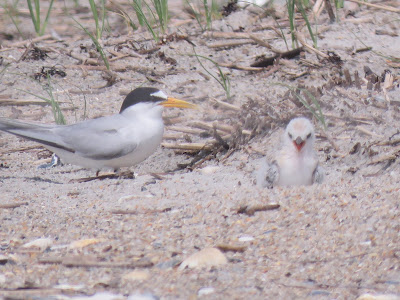Lots of parents with chicks celebrating Father’s Day!
LEAST TERNS (LETE) – Incubation and hatching continues for the Least Terns and most of the day is spent feeding and protecting their chicks from the heat and potential predators.
Look for chicks in and around the “chick shelters.” The shelters appear to be helpful! As the days become hotter, you will see the parent birds continuing to protect their chicks from heat stress by shading them or standing close to the chicks as the chicks seek shelter/shade by a nearby plant or chick shelter. We are seeing more LETE chicks than last week and 2 fledglings were seen this week.
On Monday, 6/14, a LETE fledgling was seen practicing with its new wings jumping and flapping its wings about 3-4’ off the ground. The parent bird was close by encouraging the activity! Yesterday, 6/17, we saw the parent bird accompany the new fledgling with a flight over the inlet!
COMMON TERNS (COTE) – Common Tern chicks can be seen throughout the posting and the COTE parents have been actively keeping beachgoers (and bird stewards!) a safe distance away. We have 15 Common Tern nests throughout the posting and two of the nests are very close to the string and feeding can be easily seen without the use of binoculars. One COTE pair has twins and the other has triplets!
Our first Common Tern fledgling was seen on 6/17 being escorted to the water by the parent bird.
BLACK SKIMMERS (BLSK) – We have 166 Black Skimmer nests and many are hatching. Chicks can be seen throughout the posting. If you see a Black Skimmer flying in with a fish, follow it with your binoculars right to its nest to feed chicks. Adorable! Nesting and incubation continues.
AMERICAN OYSTERCATCHERS (AMOY) – We have two Oystercatcher chicks on the beach by the AMOY pair that nested on the inlet side of the colony. The Oystercatcher family made its appearance early Monday morning (5/24) so they are now almost 4 weeks old and growing. The chicks have good size! So adorable…you will just like to watch them all day!
As you are aware, we had serious injuries to both parent AMOYs with a fishing line entangling the male parent and a few days later, the female dislocated her leg. The female with the dislocated leg was seen several evenings at sunset resting with the chicks last week. You will also remember that Lindsay was able to band both parent birds with green field-readable bands EMY and ERY when she captured the injured bird to untangle the fishing line on Friday 6/4.
The banding of the AMOY parents has enabled us to see a very unusual American Oystercatcher behavior in caring and feeding of these 2 chicks. We have not seen the two banded parents together this week. It appears that another unbanded oystercatcher has become a “helper” to the male parent EMY in protecting and feeding the chicks. Chicks have been observed being fed and protected by both EMY and the unbanded adult oystercatcher. On Wednesday and Thursday this week (6/16 & 17) IEMY and the unbanded adult were observed flying onto the beach together with food from the inlet marsh and fed the two chicks at the same time.




















































